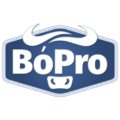Identify High SCC Cows
Identify high risk cows with milk recording and use data to help make your decision. For example, consider culling persistently infected cows and treat new cases. Milk recording should be carried out at least 4 times annually.
Teat spray and Disinfectants
Use High quality teat spray post milking always and pre milking if there’s an issue, and make sure to get good teat coverage. I had been using Bacto-Lac teat spray and achieving SCC’s of 100k. I changed to BóPro premium teat spray which took our SCC’s down to a rolling average of 61k – 70k in a short space of time.
Properly wash and disinfect milking equipment using a chlorine-free detergent. I use high strength Defender which also dramatically reduces my thermoduric bacteria results also.
Reduce the spread- Know what you’re dealing with.
Have known high SCC cows in a separate group and milk last to prevent passing it on to other cows in the herd. Take samples from High SCC cows and send off for analysis to know what specific bacteria you’re dealing with and what specific antibiotic will cure it.
Keep on top of it.
We draw out first milk from every cow twice per week when housed and once per week when grazing. We also CMT (California Mastitis Test) every cow after calving before we send her milk to the tank.
General Hygiene.
Cubicles are cleaned and limed twice daily, even when dry. Keep cow’s tails trimmed. Ensure roadways are kept clean and collecting yards cleaned regularly. Good milking routine and ensure milkers gloves/sleeves are rinsed off regularly.
Dry Period.
Drying off the cow is one of the most important jobs of the year and must be done correctly. Ensure end of teat canal is spotless and disinfected with surgical
spirits before administering dry cow therapy. Drying off can be a tedious job so I find it’s important to break them down into small groups, as people tend to become bored and more careless. We try to ensure no one has to do more than 30/40 cows on any given day.
Heifer Management Pre-Calving
It’s important that hygiene is taken even more seriously in a heifer’s environment before calving. Heifers don’t have an artificial teat seal and are relying on their own natural seal, and this natural seal tends to be less effective the closer they get to calving. Stress has also been linked to high SCCs so it’s important to minimise that in your most high-risk group. We train all the heifers to the parlour well in advance of calving and mix them in with the rest of the herd in lots of time to allow them to settle in.




